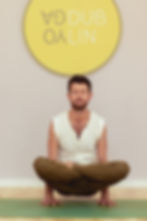Backbends - Bliss & Joy or Suffocation & Trepidation?
- Robbie Cully
- Mar 15, 2022
- 2 min read
Updated: Aug 12, 2022

Backbending much like any posture in our practice can lead to bliss and joy - or suffocation and trepidation. Unfortunately it is the latter that tends to be the most common occurrence for many people.
When we back-bend we really are meddling with the body’s response mechanisms. Generally speaking, the backbends induce a sympathetic nervous response which fires our body up and focuses our attention - great in a meditative and introspective sense. Ideally, to meditate or move our body in a controlled manner we want to be vigilant and finally attuned to our senses.
However if this ‘firing’ up isn’t meditative nor controlled… if we feel the fire but also the burn, then this is not Yoga.
If this sounds like you then read on.

See, depth in a backbend is terribly misunderstood. We don’t need to strive for it and we definitely don’t need to push, strain or hold our breath, common sensations we have all experienced when asked to come to an Upward Facing Dog (Urdhva Mukha Svanasana) or Cobra (Bhujangasana) for example.
There are many dynamics at play when approaching the backbend.
In the "Intro to backbending workshop" we will look at the factors of pushing/pulling as well as opening/closing. More often than not we are prioritising one of these factors to the complete detriment of the other. All push leads to no pull whilst an obsession with opening closes other parts of the body which diminishes our comfort in the pose from the off.
This is why the subtleties of yoga are much more than a left/right side dynamic for example. We need to make sure we have steadiness IN ease, stability WITH comfort, hence Patanjali’s aphorism ‘sthira sukham asanam’ (YS 2.46).
In this workshop we will also work toward undoing any habit that has been cemented that has resulted in our backbends being too ‘back’ orientated. In other words, if we try to isolate our spine in a backbend, the natural tendency is that we burden the lower back. This is often why we feel pinching or compression in this area.
The result is contraction rather than the expansion that we’re aiming for.
The magic of Yoga is that we witness and feel the whole body as it works in tangent. We must learn to distribute the work of the pose across the whole body. To do this, our focus will reorient to other specific areas of the body, looking at some exercises that will allow us to form a strong foundation upon which to build our backbends and support our spine.
Ultimately backbending, like all poses, should allow us to find moments of introspection even if the body is working hard, and to do this we need to work the body into comfort in order to make the mind comfortable, not the other way around.

